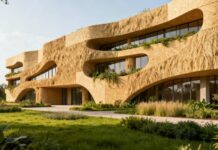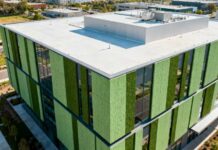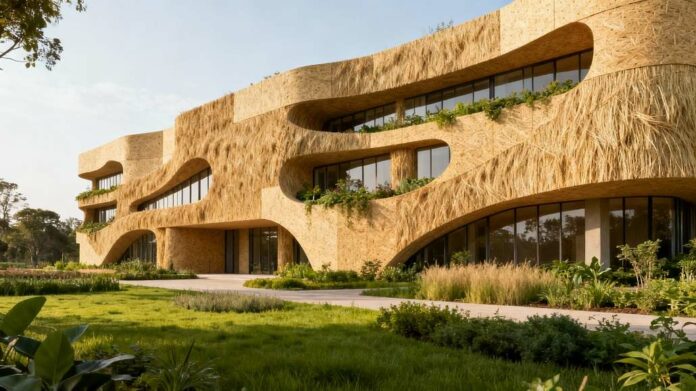For most of architectural history, buildings served their environmental function despite rather than in harmony with natural systems. Construction consumed vast material resources. Manufacturing processes generated substantial emissions and waste. Completed structures often proved thermally inefficient, requiring continuous mechanical systems to maintain occupant comfort. Demolished buildings created mountains of landfill waste. This extractive approach to construction—taking resources from nature without reciprocal benefit—has become increasingly untenable as environmental challenges escalate and sustainability imperatives strengthen.
Bio-composites in architecture represent an emerging response fundamentally reimagining the relationship between built environment and natural systems. Rather than viewing buildings as separate entities imposed upon natural landscapes, bio-composites enable structures operating in concert with ecological principles. Natural fiber composites incorporating sustainable materials like flax, hemp, and wood fibers create building materials simultaneously delivering technical performance and environmental harmony.
The architectural and design communities increasingly recognize that bio-composites enable simultaneous achievement of sustainability objectives and aesthetic excellence. Rather than sustainability constraining design possibilities, natural fiber materials increasingly inspire architectural innovation. Projects worldwide demonstrate that bio-composite architecture delivers buildings proving stronger, more beautiful, more durable, and more environmentally responsible than conventional approaches could achieve.
Understanding Bio-Composites: Natural Fibers, Sustainable Matrices
Bio-composites consist of reinforcing fibers derived from renewable agricultural resources embedded within matrices formulated from bio-based or recycled materials. This compositional focus on renewable and circular economy principles distinguishes bio-composites from conventional composites employing synthetic fibers and petroleum-derived matrices.
Natural Fiber Reinforcements and Their Characteristics
Hemp represents perhaps the most versatile natural fiber for composite applications. Hemp plants mature in approximately 100 days, regenerating rapidly without requiring intensive agricultural inputs. Production yields approximately 8 to 10 tons of fiber annually per hectare—substantial productivity enabling large-scale deployment without excessive land requirements. During growth, hemp plants sequester approximately 15 tons of atmospheric carbon dioxide per hectare annually, creating carbon storage embedded within harvested fibers.
Hemp fibers demonstrate mechanical properties—tensile strength, modulus, elongation—comparable to glass fiber at one-third the density. Composite structures incorporating hemp fiber reinforcement achieve strength-to-weight ratios approaching glass fiber composites while delivering substantial environmental advantages. A vehicle component manufactured from hemp fiber composite instead of glass fiber composite might weigh 30 percent less while maintaining equivalent strength.
Flax fibers offer similar advantages with slightly different performance characteristics. Flax exhibits lower density than hemp, enabling lightweight applications where minimal mass proves particularly valuable. Natural aesthetic qualities—subtle coloration, woven texture—make flax visually distinctive, enabling architectural applications where composite appearance directly influences design expression. The University of Stuttgart’s ITECH Pavilion demonstrates flax structural capabilities through 20 roof beams created from filament-wound flax fiber composites, proving that natural fibers support demanding load requirements.
Wood fibers, derived from sawmill waste and forestry byproducts, provide renewable reinforcement transforming waste into valuable material. Wood fiber composites demonstrate particularly strong environmental credentials when incorporating industrial byproducts otherwise destined for combustion or landfill. Performance characteristics align with natural fiber applications, enabling structural deployment comparable to hemp and flax alternatives.
Jute, sisal, and cellulose fibers represent additional natural reinforcements increasingly appearing in bio-composite applications. Cellulose fibers demonstrate particular promise for internal insulation applications where thermal and acoustic performance combine with environmental characteristics creating comprehensive sustainability profiles.
Bio-Based Matrices and Circular Economy Integration
Traditional composite matrices employ petroleum-derived epoxy or polyester resins—materials generating substantial embodied carbon during production and creating disposal challenges at end-of-service life. Bio-composites increasingly employ matrices derived from renewable resources or recycled materials, fundamentally transforming lifecycle environmental impact.
Plant-derived polyurethane matrices, formulated from vegetable oils, reduce embodied carbon by 30 to 50 percent compared to petroleum-derived alternatives. These bio-based matrices maintain mechanical properties required for structural applications while delivering reduced environmental burden. Soy-based polyurethane demonstrates particularly promising performance characteristics alongside excellent sustainability credentials.
Epoxy matrices derived from cashew nut shell liquid—an agricultural byproduct formerly considered waste—transform waste streams into valuable composite matrices. These matrices achieve mechanical properties approaching conventional epoxy while incorporating waste valorization supporting rural agricultural sectors. The circular economy integration—taking agricultural waste and converting into high-performance material—exemplifies how bio-composites align with contemporary sustainability principles.
Thermoplastic matrices derived from bio-based feedstocks present additional advantages for circular applications. Unlike thermoset matrices requiring degradation when recycling becomes necessary, thermoplastic matrices soften upon heating, enabling reshaping and reprocessing. Composite components incorporating thermoplastic matrices can be recovered at end-of-life, melted, and reformed into new applications—enabling true circular material flows.
Architectural Applications Spanning Interior to Infrastructure
Bio-composites in architecture support diverse applications from interior finish systems to exterior facades to structural elements, demonstrating adaptability across architectural scales and contexts.
Interior Applications and Design Expression
Bio-composite interior finishes leverage natural fiber aesthetics creating visual distinction aligning with contemporary design sensibilities emphasizing connection to natural materials. Cork-based composites, incorporating waste cork from wine bottle production, create interior acoustic panels simultaneously managing sound while expressing sustainable design intent. The natural texture and warm coloration create spaces reflecting environmental values.
Mycelium-based composites grown from fungal networks on agricultural residue create fully biodegradable interior elements including panels, decorative elements, and acoustic systems. These materials, grown rather than manufactured, demonstrate sustainability principles carried through production methodologies. Upon end-of-life, mycelium composites biodegrade returning completely to natural cycles without generating persistent environmental contamination.
Hemp fiber composites create insulation layers between interior finishes and structural systems, providing thermal and acoustic benefits while embodying environmental principles. Wall assemblies incorporating hemp-based composite insulation reduce heating energy requirements by 40 to 50 percent compared to conventional insulation, delivering direct economic benefit to building occupants through reduced utility costs.
Exterior Façade Systems and Urban Design Integration
The Cité Scolaire Internationale Jacques Chirac in Marseille demonstrates how bio-composite facade systems achieve architectural sophistication while delivering performance and sustainability. The 880 flax fiber composite shading panels, designed by internationally acclaimed architects Rudy Ricciotti and Roland Carta, provide dynamic solar control reducing cooling loads while maintaining visual connection between interior spaces and exterior environment.
The lightweight nature of composite panels enables architectural solutions where conventional heavy materials would prove structurally prohibitive. Curved, sculptural surfaces created from composite panels express architectural creativity impossible with conventional materials. The natural fibers provide aesthetic qualities evoking organic forms—a design language increasingly resonating with contemporary environmental consciousness.
Amsterdam’s NEMO Science Museum features façades incorporating natural fiber composites in vibrant green cladding designed by architect Renzo Piano. The bio-based composite panels create an exterior expression of sustainable design principles integrated throughout the building. The visual prominence of natural materials signals architectural commitment to environmental stewardship, transforming building facades from mere environmental barriers into expressions of sustainability values.
Structural Applications Demonstrating Material Maturity
The University of Stuttgart’s ITECH Pavilion 2024 represents a milestone in bio-composite architectural deployment, demonstrating structural applications proving natural fiber composites support demanding engineering requirements. Twenty roof beams constructed from filament-wound flax fibers span significant distances while supporting roof loads. The structure proves that natural fiber composites satisfy structural performance requirements enabling primary load-bearing applications.
This advancement transforms perception of bio-composites from specialty non-structural materials into legitimate structural alternatives. When flax fibers demonstrate adequate strength supporting roof loads, the distinction between bio-composites and conventional composites narrows to environmental and sustainability factors rather than performance limitations.
The filament winding manufacturing approach—wrapping fibers around mandrels under controlled tension—creates precise fiber orientation aligning fibers with primary load paths. This manufacturing precision enables optimal material utilization, minimizing volume while maintaining performance. The resulting beams demonstrate that deliberate design and manufacturing approaches enable bio-composites to achieve engineering efficiency approaching or equaling conventional alternatives.
Environmental Performance and Sustainability Metrics
Bio-composites in architecture deliver quantifiable environmental benefits across production, operational, and end-of-life phases.
Production Phase Carbon Reduction
Composite production generates substantially lower embodied carbon compared to conventional materials. Hemp fiber growth sequesters atmospheric carbon—production of one ton of hemp fiber composite incorporates approximately 15 tons of carbon sequestration potential. Net result: hemp composite structural elements prove carbon-negative even accounting for manufacturing energy and processing emissions.
Flax production similarly sequesters atmospheric carbon, though at slightly lower rates than hemp. Both natural fibers demonstrate carbon-positive profiles where incorporated carbon stored in harvested fibers exceeds manufacturing process emissions—a performance profile conventional materials cannot achieve.
Glass fiber production generates 0.18 tons of carbon dioxide per ton produced. Hemp fiber composite production incorporating bio-based matrices might generate 0.10 to 0.12 tons of carbon dioxide per ton. The environmental advantage extends beyond simple carbon accounting into comprehensive emission reduction across production phases.
Operational Phase Energy Reduction
Building thermal performance determines lifecycle operational energy consumption—frequently the largest environmental cost component. Bio-composite insulation materials incorporating hemp, flax, or natural fiber matrices reduce heating and cooling requirements by 40 to 60 percent compared to conventional insulation approaches.
A 5,000-square-meter office building incorporating bio-composite insulation might reduce annual heating energy consumption from 400 megawatt-hours to 200 to 240 megawatt-hours. Across a 50-year building lifespan, this operational energy reduction prevents approximately 4,000 to 8,000 tons of carbon dioxide emissions. This operational benefit dwarfs all production-phase environmental impacts, creating structures with dramatically positive lifecycle environmental profiles.
Natural fiber composites demonstrate superior acoustic properties reducing exterior noise penetration by approximately 30 percent compared to conventional construction. Superior acoustic performance enables reduced mechanical systems for acoustic control—eliminating mechanical equipment reducing operational energy and environmental impact.
End-of-Life and Circular Economy Integration
Unlike conventional composites requiring energy-intensive specialized recycling or landfill disposal, bio-composites incorporating natural fibers and bio-based matrices enable sustainable end-of-life processing. Biodegradable bio-composites can safely decompose in controlled environments, returning carbon to natural cycles without generating persistent environmental contamination.
Compostable bio-composites incorporating agricultural residues and bio-based matrices represent circular economy exemplars. Upon end-of-life, these materials biodegrade yielding soil amendments supporting agricultural productivity. The complete lifecycle—from agricultural production through building deployment through eventual return to soil—represents a closed loop respecting natural cycles rather than generating persistent waste.
Even non-biodegradable bio-composites demonstrate superior recycling characteristics compared to conventional alternatives. Natural fibers facilitate recycling through reduced processing complexity. Bio-based matrices enable thermal recycling yielding energy recovery without generating toxic byproducts from petroleum-derived matrix combustion.
Technical Performance and Building Code Integration
Initial skepticism regarding bio-composite building applications reflected legitimate concerns about technical performance and durability under demanding service conditions. Contemporary research increasingly demonstrates that properly designed and manufactured bio-composites satisfy rigorous performance requirements.
Structural Performance Validation
Research programs validating bio-composite structural capability demonstrate that carefully designed natural fiber composites achieve mechanical performance supporting structural applications. Testing of hemp fiber composite beams reveals tensile strength values of 120 to 150 megapascals—adequate for many structural applications. Modulus values of 7,000 to 10,000 megapascals prove sufficient for deflection control.
While individual fiber properties remain somewhat lower than glass or carbon fiber alternatives, bio-composite structural systems prove capable through geometric optimization and strategic fiber orientation. Designers compensate for lower individual fiber properties through increased cross-sectional area and optimal fiber arrangement—engineering solutions enabling performance achievement despite lower base material properties.
Durability and Environmental Resistance
Natural fiber durability concerns stem from moisture sensitivity and potential for biological degradation under persistent moisture conditions. Comprehensive research demonstrates that properly protected bio-composites exhibit durability characteristics exceeding conventional expectations. Bio-based matrix systems incorporating bio-resistant additives provide protection against fungal growth and biological attack.
Field deployments spanning one to two decades demonstrate that bio-composites protected from direct moisture exposure maintain mechanical properties without apparent degradation. The ITECH Pavilion flax structures, exposed to full environmental conditions for several years, exhibit no observable performance degradation. Long-term monitoring will clarify extended service life, but preliminary data suggest durability adequate for building applications.
Building Code Recognition and Standardization
Building codes increasingly accommodate bio-composite materials through performance-based compliance pathways. Rather than requiring adherence to prescriptive standards written for conventional materials, codes increasingly enable demonstration of equivalent performance through testing and documentation. This performance-based approach enables bio-composite adoption without requiring fundamental code restructuring.
Standards development organizations are creating specifications for bio-composite structural applications. These standards will formalize design approaches, testing requirements, and qualification criteria enabling mainstream architectural deployment. As standards mature and code acceptance develops, adoption barriers will diminish progressively.
Urban Design and Landscape Integration
Bio-composite architecture extends beyond individual building elements into urban landscape and infrastructure applications where natural fiber materials prove particularly valuable.
Green Infrastructure and Living Systems Integration
Bio-composites prove excellent materials for green infrastructure elements—rain gardens, bioswales, permeable pavements—where moisture and biological activity characterize the operating environment. Flax-based composites incorporated into green roof modules provide structural support for vegetation while enabling water drainage. Unlike aluminum alternatives, bio-composite systems biodegrade eventually, creating truly circular systems where infrastructure returns to soil.
Pergolas and shade structures fabricated from bio-composite materials provide aesthetic urban design elements while minimizing environmental footprint. The natural appearance creates visual harmony with surrounding vegetation while embodying environmental principles through material selection.
Parametric Design and Material Expression
Contemporary computational design approaches enable optimization of bio-composite forms exploring organic geometries expressing natural material characteristics. Parametric design scripts optimize material distribution minimizing volume while maintaining performance—a computational-enabled design approach gaining traction in sustainable architecture.
The resulting structures frequently exhibit organic forms echoing natural systems while demonstrating sophisticated engineering. These designs express environmental values through form language—elevating sustainability from checklist compliance into aesthetic expression differentiating buildings architecturally while advancing environmental objectives.
Implementation and Adoption Pathways
Successful bio-composite architectural deployment requires attention to design integration, supply chain development, and construction methodology adaptation.
Design Phase Integration and Material Exploration
Architects and designers should engage materials specialists during early project phases, exploring how bio-composite properties enable design solutions advancing project objectives. Rather than retrofitting bio-composites into conventional designs, optimal outcomes emerge from designs conceived explicitly around natural fiber composite capabilities.
Material samples, physical prototypes, and testing programs help designers develop intuitive understanding of natural fiber composite characteristics. Hands-on engagement with materials generally proves more effective than theoretical study for understanding how natural materials can serve architectural intent.
Local Sourcing and Regional Supply Chains
Bio-composite deployment benefits substantially from local agricultural sourcing reducing transportation impacts and supporting regional agricultural sectors. Projects in regions with hemp and flax production capability enjoy supply chain advantages enabling cost reduction and environmental benefit optimization.
Building regional supply chains requires sustained commitment and demand. Early adopter projects accepting slightly higher costs to establish supply infrastructure create pathways enabling broader deployment. As regional demand develops, costs decline and supply reliability improves progressively.
Workforce Development and Construction Knowledge
Bio-composite architectural deployment requires construction workforce capable of executing installations meeting performance requirements. Training programs helping construction personnel understand natural fiber composite characteristics, proper installation methodology, and performance verification will support broader adoption.
Material manufacturers increasingly provide training and technical support enabling construction workforce capability development. As early projects accumulate, construction personnel directly experience natural fiber composite capabilities and appropriate handling approaches, distributing knowledge progressively across construction industry.
Future Directions and Emerging Opportunities
Bio-composites in architecture continues evolving through advanced fiber developments, innovative matrix formulations, and integration with emerging building technologies.
Programmable bio-composites represent an emerging frontier where material properties adjust in response to environmental conditions. Fibers with temperature-responsive properties could adjust stiffness or configuration responding to thermal conditions. Materials incorporating shape memory alloys might enable active structures responding to loads or environmental stimuli.
Three-dimensional printing of bio-composite structures enables geometric optimization and waste minimization previously impossible. Topology optimization algorithms discover optimal material distributions creating structures with minimal mass while maintaining performance. 3D-printed bio-composites could represent the next generation of sustainable architectural material.
Integration of bio-composites with renewable energy systems—embedding photovoltaic coatings in facades, integrating piezoelectric fibers generating energy from structural vibration—transforms buildings incorporating bio-composites into net-energy producers rather than energy consumers. This evolution would represent architectural transformation enabling buildings to contribute environmental benefits rather than imposing environmental burdens.
Conclusion: Natural Materials Commanding Built Environment Future
Bio-composites in architecture represents far more than marginal alternative for sustainability-motivated designers. These materials demonstrate technical capability supporting demanding architectural requirements while simultaneously delivering environmental benefits impossible for conventional approaches. The convergence of performance adequacy, environmental advantage, and design potential creates compelling rationale for progressive adoption across construction industry.
For architects, designers, and builders committed to environmental responsibility without accepting performance compromises, bio-composites represent essential tools enabling next-generation buildings expressing sustainability through material selection and form language. The evidence from projects worldwide demonstrates that sustainable architecture incorporating natural fiber materials proves simultaneously environmentally responsible and architecturally distinguished.
As supply chains develop, construction expertise accumulates, and building codes recognize bio-composite capabilities, these natural materials will progress from emerging innovations toward mainstream architectural deployment. Organizations positioning themselves today to understand, design with, and deploy bio-composites effectively will lead the architectural evolution toward built environments operating in harmony with natural systems while delivering exceptional performance and beauty. The future of sustainable architecture increasingly appears distinctly natural—rooted in fibers drawn from earth, processed with care, and deployed through design celebrating material authenticity and environmental stewardship.
































